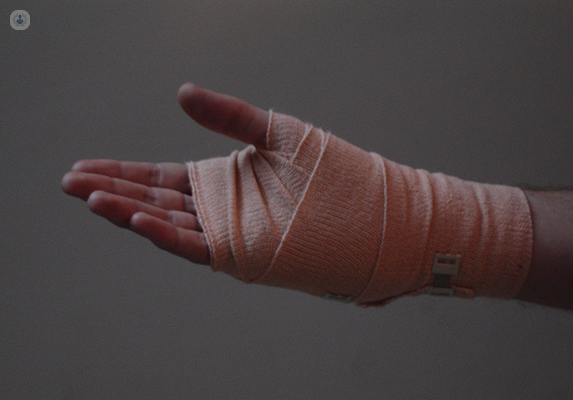Functional bandage
What is a functional bandage?
A functional bandage is a type of bandage that is used for partial immobilisation of a joint in tendon, muscle and ligament injuries. It allows for a certain degree of mobility, while keeping the joint from moving too much and worsening the injury.

The advantage of this type of bandage is that it avoids the inconveniences of complete immobilisation (loss of muscle mass, loss of bone density or osteoporosis, circulation problems, thromboembolism, etc.).
The functional bandages can be:
- Preventive – these may be used by athletes, including martial artists, to prevent injuries such as dislocations. They are also useful to prevent further damage to chronic injuries or to prevent recurrent injuries in weakened tissues.
- Therapeutic bandages – used to treat injuries to muscles, tendons, and ligaments, they limit the range of motion of the joint, while providing support. This minimises pain and the risk of aggravating the injury. They may be used after a hard cast has been removed to help the muscles of the joint get used to activity again.
What is it for?
Severe injuries may require a joint to be completely immobilised, but this comes with potential negative side-effects. With the muscles unable to move, they may become subject to atrophy, and the lack of movement increases the risk of blood clots. For this reason, unless complete immobilisation is necessary, functional bandages are preferential to keep the muscles active and healthy during the healing process.
The objectives of every functional bandage are:
- Exert some pressure on the wounds, to contain haemorrhages.
- Keep splints in place.
- Limit the movements of the injured joint, but not completely.
- Facilitate the regeneration of tissues, by allowing movement.
- Correct deformities.
- Prevent further injuries due to indirect trauma.
- Prevent possible deformities.
Preparation for a functional bandage
Before placing a functional bandage it is necessary that the area be properly cleaned and shaved, to ensure maximum adhesion and functionality of the bandage. If the patient has a wound or rash in the area where the bandage is to be applied, it should first be treated with antiseptic and possibly a hydrating gel. Then the area is pre-taped with an “underwrap” dressing, over which the functional bandage is placed.
Care after the intervention
After the intervention the patient should be aware that they still have an injury, despite being bandaged and so they should be cautious with the movements and forces exerted on it. In case of pain, the specialist will recommend the best course of action depending on the case and injury.
